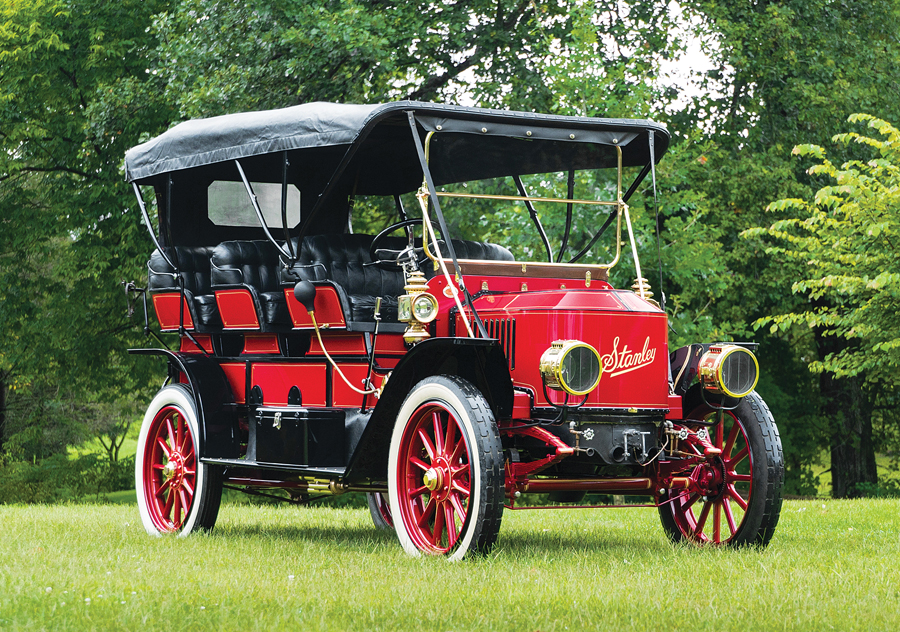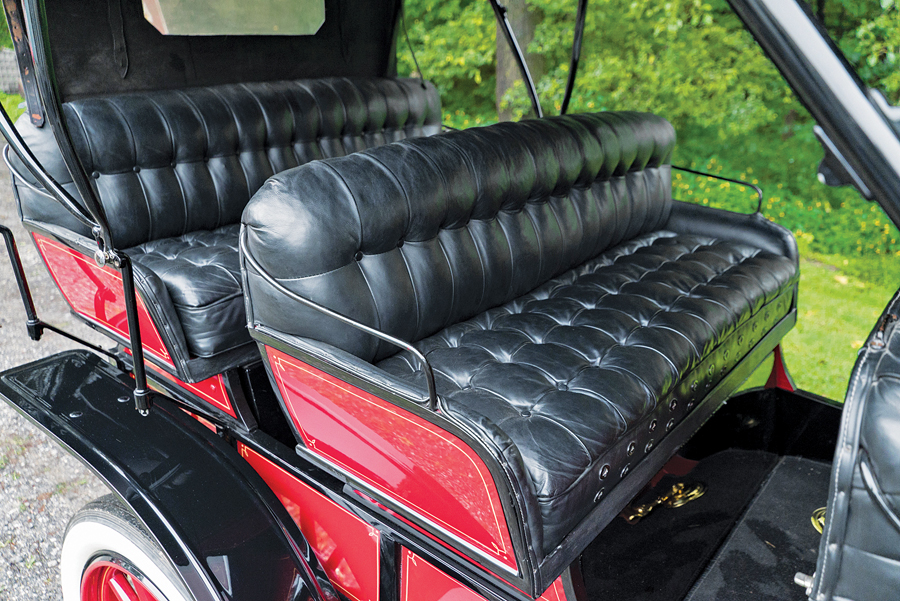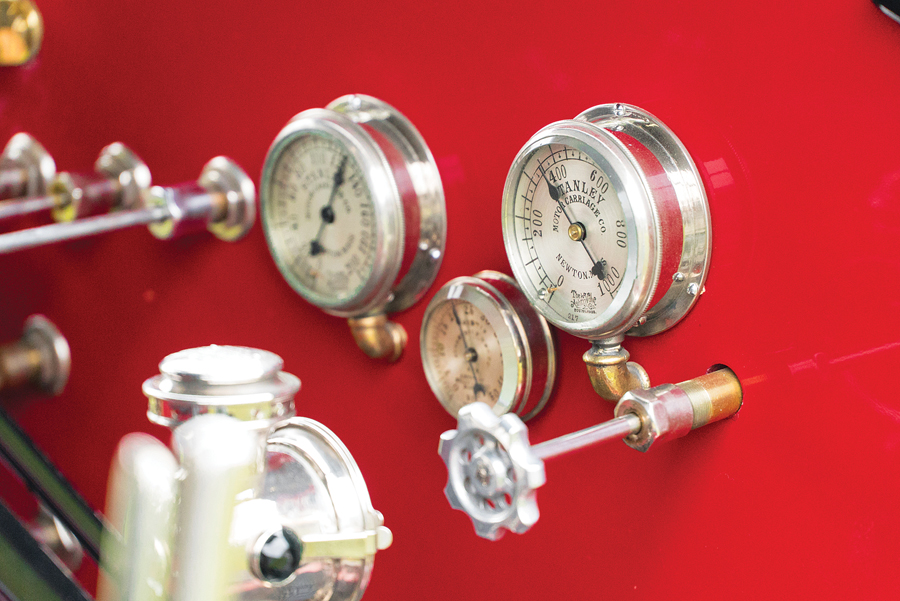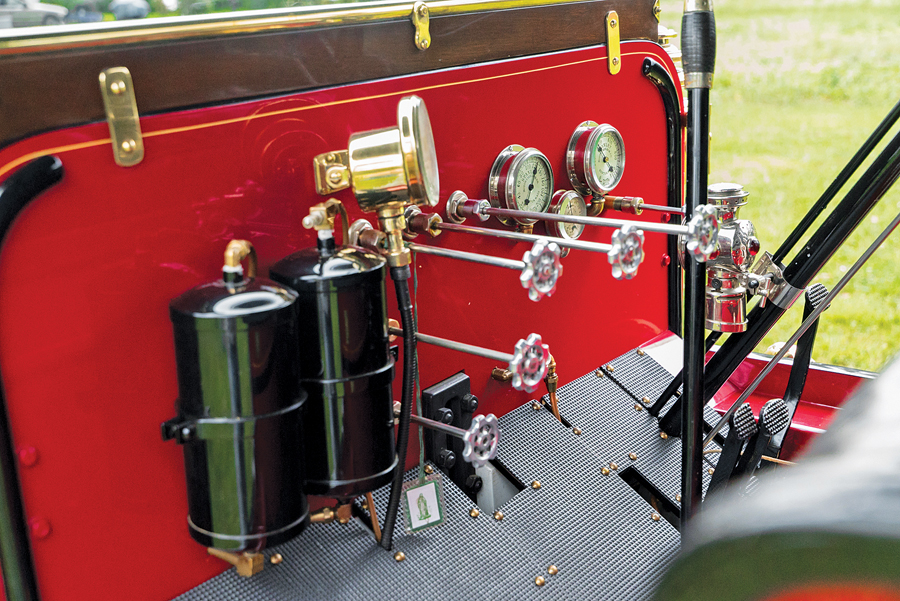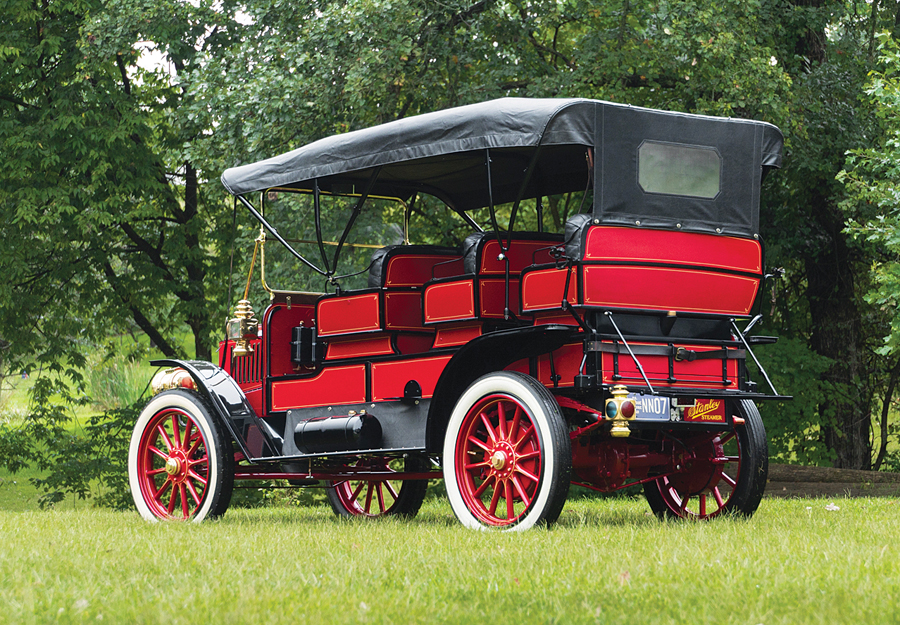- Former Antique Automobile Club of America First Junior and Senior Award winner
- Beautiful Mountain Wagon re-creation by Stanley enthusiast Carl Amsley
- Restoration completed in the early 2000s by Daryl Kendall
- New boiler installed in 2009
SCM Analysis
Detailing
| Vehicle: | 1909 Stanley Model Z Mountain Wagon |
| Years Produced: | 1909–17 |
| Number Produced: | N/A |
| Original List Price: | N/A |
| SCM Valuation: | $164,500 |
| Tune Up Cost: | N/A |
| Chassis Number Location: | Brass plate, rear of body |
| Engine Number Location: | N/A |
| Club Info: | Stanley Register Online |
| Website: | http://www.stanleyregister.net |
| Alternatives: | 1901–11 White, 1906–30 Doble, 1902–23 Stanley |
| Investment Grade: | C |
This car, Lot 167, sold for $130,000, including buyer’s premium, at RM Sotheby’s auction in Hershey, PA, on October 12, 2018.
In the world of steam cars, Stanley is by far the best-known name, even though the White Motor Company actually produced many more cars. In the heyday of steam power, Stanley produced up to 775 cars per year, and averaged about 500 cars per year from 1904 to 1919 — before steam power fell out of fashion.
One claim to fame that has largely escaped notice is that the Stanley brothers appear to have invented the hotel shuttle bus.
In 1909, F.O. Stanley opened the Stanley Hotel in Estes Park, CO, and needed some people-movers to shuttle guests and luggage about 20 miles from the railway station in nearby Loveland up to his resort.
Loveland is at about 5,000 feet elevation, while the hotel sits at about 7,500 feet, and most gas-powered cars of the era couldn’t make the climb. So Stanley designed the Mountain Wagon, also known as the Model Z or Model 820, with seating for nine or 12 passengers. The Mountain Wagon was among the largest steam cars ever built, with a wooden frame and Stanley’s largest engine, good for 30 horsepower.
Bring on Jay Leno!
Whenever a steam car comes up for analysis, we like to make a call to Jay Leno. He’s an enthusiast and acknowledged expert on steam-powered vehicles.
“They’re desirable,” Leno said, “because there’s so few of them. The 30-horse motor, which is the big motor, is sort of canceled out by the sheer size and the weight of a Mountain Wagon. It makes me laugh, the idea of taking nine people in a wooden vehicle that can go 60 miles an hour, and it has two-wheel brakes!”
Not exactly original
It’s hard to make blanket statements about Brass Era automobiles because at their current age, each one is very much an individual with a unique history.
Many have been restored several times, or rebuilt from parts. Originality can be hard to nail down. Case in point: It is claimed that only one Stanley Mountain Wagon in existence (SCM# 256157) still carries its original coachwork, and it’s not this one.
The Mountain Wagon platform could also be ordered as a pickup truck, and it’s believed that some pickups have been converted to Mountain Wagons with new coachwork.
“Most of those are like Lincoln’s axe,” Leno joked. “It’s on its third handle and fifth head. But it’s still Lincoln’s axe. To me it doesn’t really matter because wood that’s a hundred years old, I’m not sure how pliable that is. So the fact that you replace it with modern wood, if it’s done properly, that’s okay.”
Raising a little steam in the market
According to the SCM Platinum Auction Database, the first recorded auction sale of a Stanley in the six-figure range was in 2003 (SCM# 31055). Since then, prices have trended upwards, but the past few years have seen several Stanleys (SCM# 271633) sell for about $50,000. The most recent sale in the database (SCM# 6874604) is an unrestored 1917 Touring car that changed hands for $19,040.
“Steam cars have risen to this new level,” Leno said. “When I got interested in them, they were $15,000 to $25,000 because the people that wanted one couldn’t afford it. They were usually working guys like boiler men, steam men or plumbers. The people that could afford a steam car didn’t want them because they were frightened by them, and thought they’d blow up.
“But once one or two of them hit Pebble Beach, they went nuts.”
Within that context, the subject sale seems like defensible money for both buyer and seller.
Leno was quick to point out that there has never been a verified case of a Stanley blowing up. The boilers are equipped with pressure-relief valves, and even if the safety valve failed, the boiler would rupture rather than explode.
A good price for a unique car
The car in question was not held out as original in every detail by the seller, but it is a rare model with only one previously recorded Mountain Wagon sale at auction (SCM# 256157). That was the all-original car, and it sold for $209,000.
This sale price of $130,000 is consistent with top-shelf Stanley sales of the past five years.
“If you buy a Stanley hoping to flip it, I have no idea what happens,” Leno said. “A Stanley is different from other cars in that they reach a price plateau and then they stay there. Then they go to the next plateau and they just stay there. I don’t think it’s a car you would ever buy for an investment. It’s one of the few cars where the joy is in the actual operating of the car.”
Steaming along
The takeaway is that prices of Stanleys are not likely to move independently of the market as a whole. With a comparatively small community of collectors and buyers, the competition necessary to drive prices up dramatically simply won’t be there. But prices are also not likely to fall much, as these cars will always be interesting and collectible. ♦
(Introductory description courtesy of RM Sotheby’s.)
